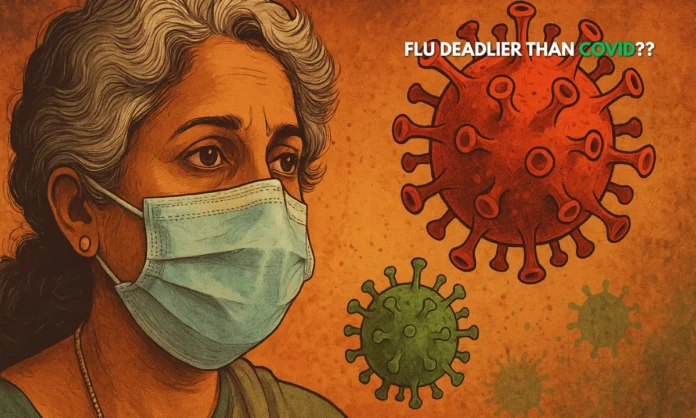SUMMARY
- Dr. Soumya Swaminathan warns that influenza likely causes more deaths than COVID-19 annually in India.
- SARS-CoV-2 now behaves like a common respiratory virus, not a pandemic threat, she says.
- Public health focus must shift toward long-term pandemic readiness, not panic.
India’s Viral Reality: Why the Panic Button Doesn’t Belong to COVID Anymore
As the world cautiously tracks new COVID-19 variants like JN.1 and NB.1.8.1, a quieter but perhaps deadlier threat continues to haunt India’s public health system—influenza. According to Dr. Soumya Swaminathan, former Chief Scientist at the WHO and ex-head of ICMR, the flu virus may be responsible for more fatalities annually than COVID-19, despite the latter dominating headlines and government responses since 2020. Her statement marks a critical reorientation in understanding the true epidemiological priorities of India in 2025.
In a detailed interview, Dr. Swaminathan underscores that SARS-CoV-2 is now endemic, circulating like any other respiratory virus. She dismisses fears of another “Delta-like” wave and emphasizes that India’s immune profile—thanks to vaccination and natural exposure—has changed drastically since the early pandemic years. Her focus now is on public education, strategic vaccine updates, and legislation for future biological threats.
As new cases rise modestly, Dr. Swaminathan warns against apathy but calls for proportionate and science-led responses. While COVID-19 may remain in the headlines, it’s influenza that silently erodes health, particularly among India’s elderly and immunocompromised populations. And yet, the flu still doesn’t spark the same urgency in public behaviour or policymaking. That could be India’s real blind spot.
VIDEO | On the spike in COVID-19 cases in India, former WHO chief scientist Soumya Swaminathan (@doctorsoumya) says, "Coronavirus will remain with us now in the future too. We will witness a spike in COVID-19 cases in the gap of a few months. However, we have a strong immune… pic.twitter.com/V26s1V0eoy
— Press Trust of India (@PTI_News) May 30, 2025
COVID-19: No Longer a Pandemic, But Still Present
- SARS-CoV-2 is now considered one of many circulating respiratory viruses.
- The JN.1 variant is dominant in India, but it causes mostly mild infections.
- Public immune response now prevents large-scale hospitalisation or deaths.
Dr. Swaminathan clarified that the “COVID panic” seen in 2020 or 2021 is unlikely to recur. She pointed out that during the initial wave, the virus was entirely new to the human immune system. Today, things are different. Antibody presence and T-cell memory make it harder for the virus to wreak the same havoc. Periodic surges every 6–8 months are normal, she said, and recent data from ICMR confirms that COVID is once again the predominant strain—but one causing mostly mild symptoms.
She reinforced that symptoms and testing positivity do not equate to hospital pressure. “We are not seeing hospitalisations like before,” she explained, advising that healthy individuals and children don’t need boosters right now. However, people with underlying health conditions must remain cautious, as COVID-19—like the flu—can still cause complications in vulnerable groups.
Influenza: The Quiet Epidemic That India Overlooks
- Influenza likely causes more annual deaths than COVID-19 in India.
- Vulnerable populations should prioritise the yearly flu vaccine.
- Public health focus needs to shift from COVID to broader respiratory threats.
Swaminathan’s most striking claim was that influenza—not COVID-19—is likely the greater annual killer in India. While COVID has occupied the public consciousness and government resources, flu viruses continue to cause deaths, particularly among elderly populations, children, and those with pre-existing conditions.
She advocated for stronger public messaging on the importance of influenza vaccines, which are updated annually. Despite their availability, uptake in India remains dismally low. Swaminathan argued that this needs to change. The general public, she noted, has wrongly come to view COVID-19 as the only serious respiratory threat, while underestimating the real toll of influenza.
“Flu vaccines make a lot of sense for vulnerable people,” she said. “But the awareness and urgency around them is missing. We need to correct that.”
From Panic to Preparedness: India’s New Public Health Imperative
- Pandemic preparedness must include new laws and a national pathogen list.
- Public health literacy and state-level response systems need urgent upgrades.
- Sensible personal precautions remain the key to future resilience.
Looking ahead, Dr. Swaminathan shifted the conversation from immediate disease surveillance to long-term resilience. She proposed five focus areas for India: enacting legislation on biological threats, developing a national list of priority pathogens, creating scalable vaccine and drug development pipelines, establishing a dedicated public health workforce in every state, and increasing public engagement on health issues.
“Public health isn’t just about hospital beds and ventilators—it’s about education, preparedness, and legislation,” she said. She also stressed the need for health literacy and behavioural change, pointing out how maskless sneezing and coughing in crowded buses and trains continue to spread infections unnecessarily.
Swaminathan remains optimistic but realistic. COVID-19 is now endemic, and our collective immune system is ready to fight it. But that does not mean the battle is over—it just means the battlefield has changed.
Endemic, Not Emergency: Time to Reset the Narrative
Dr. Soumya Swaminathan’s remarks offer a vital recalibration of public understanding. COVID-19 may still be among us, but it no longer demands the emergency footing it once did. The real challenge lies in our outdated perceptions, lopsided vaccine priorities, and institutional unpreparedness for future biological threats.
Influenza continues to quietly claim lives in far greater numbers—without triggering headlines or public policy debates. As India charts its post-pandemic future, the shift from panic to preparedness isn’t just advisable. It’s non-negotiable.


